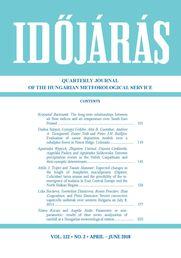IDŐJÁRÁS - angol nyelvű folyóirat
Vol. 122, No. 2 * Pages 101–216 * April - June 2018
 |
|
 letöltés [pdf: 2538 KB]
letöltés [pdf: 2538 KB]
Long-term relationships between air flow indices and air temperature over Southeast Poland
Krzysztof Bartoszek
DOI:10.28974/idojaras.2018.2.1 (p. 101–)
Krzysztof Bartoszek
DOI:10.28974/idojaras.2018.2.1 (p. 101–)
Evaluation of ozone deposition models over a subalpine forest in Niwot Ridge, Colorado
Dalma Szinyei, Györgyi Gelybó, Alex B. Guenther, Andrew A. Turnipseed, Eszter Tóth, and Peter J.H. Builtjes
DOI:10.28974/idojaras.2018.2.2 (p. 119–)
Dalma Szinyei, Györgyi Gelybó, Alex B. Guenther, Andrew A. Turnipseed, Eszter Tóth, and Peter J.H. Builtjes
DOI:10.28974/idojaras.2018.2.2 (p. 119–)
Extreme precipitation events in the Polish Carpathians and their synoptic determinants
Agnieszka Wypych, Zbigniew Ustrnul, Danuta Czekierda, Angelika Palarz, and Agnieszka Sulikowska
DOI:10.28974/idojaras.2018.2.3 (p. 145–)
Agnieszka Wypych, Zbigniew Ustrnul, Danuta Czekierda, Angelika Palarz, and Agnieszka Sulikowska
DOI:10.28974/idojaras.2018.2.3 (p. 145–)
Expected changes in the length of Anopheles maculipennis (Diptera: Culicidae) larva season and the possibility of the re-emergence of malaria in East Central Europe and the North Balkan Region
Attila J. Trájer and Tamás Hammer
DOI:10.28974/idojaras.2018.2.4 (p. 159–)
Attila J. Trájer and Tamás Hammer
DOI:10.28974/idojaras.2018.2.4 (p. 159–)
Severe convective supercells outbreak over western Bulgaria on July 8, 2014
Lilia Bocheva,Tsvetelina Dimitrova, Rosen Penchev, Ilian Gospodinov, and Petio Simeonov
DOI:10.28974/idojaras.2018.2.5 (p. 177–)
Lilia Bocheva,Tsvetelina Dimitrova, Rosen Penchev, Ilian Gospodinov, and Petio Simeonov
DOI:10.28974/idojaras.2018.2.5 (p. 177–)
Parametric or non-parametric: results of time series analyzation of rainfall at a Hungarian meteorological station
Tímea Kocsis and Angéla Anda
DOI:10.28974/idojaras.2018.2.6 (p. 203–)
Tímea Kocsis and Angéla Anda
DOI:10.28974/idojaras.2018.2.6 (p. 203–)
IDŐJÁRÁS folyóirat

Az IDŐJÁRÁS a HungaroMet Nonprofit Zrt. negyedévenként megjelenő angol nyelvű folyóirata
Megrendelhető a journal.idojaras@met.hu címen.
A szerzőknek szánt útmutató itt olvasható.
Megrendelhető a journal.idojaras@met.hu címen.
A szerzőknek szánt útmutató itt olvasható.









